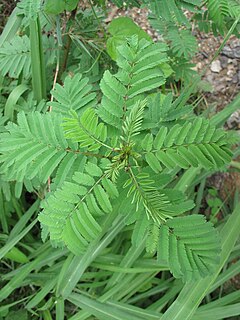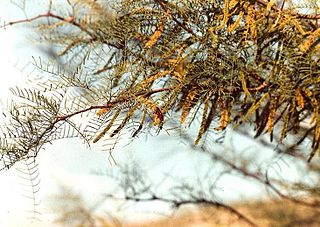
Mimosa is a genus of about 400 species of herbs and shrubs, in the mimosoid clade of the legume family Fabaceae. The generic name is derived from the Greek word μῖμος (mimos), an "actor" or "mime", and the feminine suffix -osa, "resembling", suggesting its 'sensitive leaves' which seem to 'mimic conscious life'.

The Mimosoideae are trees, herbs, lianas, and shrubs that mostly grow in tropical and subtropical climates. They comprise a clade, previously placed at the subfamily or family level in the flowering plant family Fabaceae (Leguminosae). In previous classifications, Mimosoideae refers to what was formerly considered the tribe Mimoseae. Characteristics include flowers in radial symmetry with petals that are valvate in bud, and have numerous showy, prominent stamens. Mimosoideae comprise about 40 genera and 2,500 species.

The Fabaceae or Leguminosae, commonly known as the legume, pea, or bean family, are a large and economically important family of flowering plants. It includes trees, shrubs, and perennial or annual herbaceous plants, which are easily recognized by their fruit (legume) and their compound, stipulate leaves. Many legumes have characteristic flowers and fruits. The family is widely distributed, and is the third-largest land plant family in number of species, behind only the Orchidaceae and Asteraceae, with about 751 genera and about 19,000 known species. The five largest of the genera are Astragalus, Acacia, Indigofera, Crotalaria, and Mimosa, which constitute about a quarter of all legume species. The ca. 19,000 known legume species amount to about 7% of flowering plant species. Fabaceae is the most common family found in tropical rainforests and in dry forests in the Americas and Africa.

Cercis is a genus of about 10 species in the subfamily Cercidoideae of the pea family Fabaceae, native to warm temperate regions. It contains small deciduous trees or large shrubs commonly known as redbuds. They are characterised by simple, rounded to heart-shaped leaves and pinkish-red flowers borne in the early spring on bare leafless shoots, on both branches and trunk ("cauliflory"). Cercis is derived from the Greek word κερκις (kerkis) meaning "weaver's shuttle", which was applied by Theophrastus to C. siliquastrum.

Gleditsia is a genus of trees in the family Fabaceae, subfamily Caesalpinioideae, native to North America and Asia. The Latin name commemorates Johann Gottlieb Gleditsch, director of the Berlin Botanical Garden, who died in 1786.

Parkinsonia, also Cercidium, is a genus of flowering plants in the pea family, Fabaceae. It contains about 12 species that are native to semi-desert regions of Africa and the Americas. The name of the genus honors English apothecary and botanist John Parkinson (1567–1650).

Mimosa nuttallii, the Nuttall's sensitive-briar, catclaw brier, or sensitive brier, is an herbaceous perennial legume in the subfamily Mimosoideae native to the central United States. It has a trailing semiwoody vine covered with small recurved prickles that can be painful to bare skin.

Neptunia lutea, commonly called the yellow-puff, is an herbaceous plant in the legume family (Fabaceae). It is native to the United States, where it is primarily found in the South Central region, extending eastward into the Blackland Prairies of Alabama and Mississippi. Its natural habitat is in open areas such as prairies and savannas. It is tolerant of disturbed soil.

Desmanthus is a genus of flowering plants in the mimosoid clade of the subfamily Caesalpinioideae of the pea family, Fabaceae. The name is derived from the Greek words δεσμός (desmos), meaning "bundle", and ἄνθος (anthos), meaning "flower". It contains about 24 species of herbs and shrubs that are sometimes described as being suffruiticose and have bipinnate leaves. Desmanthus is closely related to Leucaena and in appearance is similar to Neptunia. Like Mimosa and Neptunia, Desmanthus species fold their leaves in the evening. They are native to Mexico and North, Central and South America. Members of the genus are commonly known as bundleflowers. Donkey beans is another common name and originated in Central America, where Desmanthus species are highly regarded as fodder for these domestic draught animals.

Leucaena is a genus of flowering plants in the mimosoid clade of the subfamily Caesalpinioideae of the legume family Fabaceae. It contains about 24 species of trees and shrubs, which are commonly known as leadtrees. They are native to the Americas, ranging from Texas in the United States south to Peru. The generic name is derived from the Greek word λευκός (leukos), meaning "white," referring to the flowers.

Mimosa pigra, commonly known as the giant sensitive tree,, is a species of the genus Mimosa, in the family Fabaceae. It is native to the Neotropics, but has been listed as one of the world's 100 worst invasive species and forms dense, thorny, impenetrable thickets, particularly in wet areas.

Mimosa diplotricha is a species of leguminous woody shrub native to the Neotropics. It is an invasive species and now has a pantropical distribution. It is commonly known as the giant sensitive plant, giant false sensitive plant, or nila grass.
Mimosa invisa is a species of leguminous woody shrub or vine native to South America. Mimosa invisa includes two subspecies, each with two varieties: The species is considered to be noxious and invasive in much of the United States.
Adenopodia is a genus of legume in the family Fabaceae, that occurs in the northern Neotropics and Africa. They may grow as lianas, shrubs or trees. The petioles have a distinct gland above their base, hence the Greek name which is a combination of "gland-" and "foot".
Mimosa ophthalmocentra, Jurema-embira is a tree in the family Fabaceae. It is native to Brazil. It is shrub or small tree about 3 to 5 m tall. Its blossoms come in long, narrow cylindrical spikes having yellowish white petals and a white stamen. The blossoms are sometimes found to have a pink tinge. The fruit is green, sometimes with red or purple, flat, about 8 cm long and about 1 cm wide.

Desmanthus bicornutus is a species of flowering plant in the legume family native to northern and central Mexico and the southwestern United States. It is an "abundant roadside weed across its native range." It is known by the common names ruby bundleflower, two-horn bundleflower, and in Mexican Spanish malvilla de laguna.

Mimosa rubicaulis is a shrub belonging to Fabaceae and subfamily Mimosoideae. It is bipinnately compound, each leaf having 8–12 pairs of pinnae, each with 16–20 pairs of pinnules, unlike Mimosa pudica which has at most two prickly pairs of leaflets. It is found across India.

Mimosa aculeaticarpa is a shrub in the family Fabaceae. It is commonly known as the catclaw mimosa or the wait-a-minute bush and is endemic to upland regions of Mexico, Arizona, New Mexico and Texas.

Wedelia acapulcensis, commonly known as Acapulco wedelia, is a species of flowering plant in the sunflower family, Asteraceae. It is native to Texas in the United States, Mexico, and Central America.

Prosopis chilensis is a species of tree in the genus Prosopis, belonging to the family Fabaceae. It is found in parts of central Chile, southern Peru, Bolivia, and Andean (northwestern) Argentina. Its common names include Chilean mesquite, cupesí, and Chilean algarrobo. It is used for providing shade, for animal feed and for firewood.
















